
Decision 2016: Tavish for President! Left? Right? Something in between? Intrepid Pup is a new breed of candidate to make America sane again. What do you think of his qualifications? Vote November 8, 2016.

Decision 2016: Tavish for President! Left? Right? Something in between? Intrepid Pup is a new breed of candidate to make America sane again. What do you think of his qualifications? Vote November 8, 2016.
Save
Save
Save
Save
Save
Save
Save
Save
Save
Save
Save
 Thomas Jefferson’s name gets bandied about quite frequently on the fourth of July. Famously linked to this date first for his role in writing the Declaration of Independence, Jefferson also made history by dying on July 4th fifty years later…the exact same day as his Declaration co-author and former political adversary John Adams.
Thomas Jefferson’s name gets bandied about quite frequently on the fourth of July. Famously linked to this date first for his role in writing the Declaration of Independence, Jefferson also made history by dying on July 4th fifty years later…the exact same day as his Declaration co-author and former political adversary John Adams.
So, on this our country’s 236th birthday, Intrepid Pup shares a recent visit to Thomas Jefferson’s hilltop home of Monticello.
Thomas Jefferson (1743-1826) was a young nation’s first Secretary of State, second Vice President, and third President…a veritable trifecta that meant he was indeed a busy man whose home—despite being started in 1768—took forty years to complete. Today, the distinctive plantation with its Palladian architectural influences is the only U.S. residence that’s also a designated UNESCO World Heritage site.
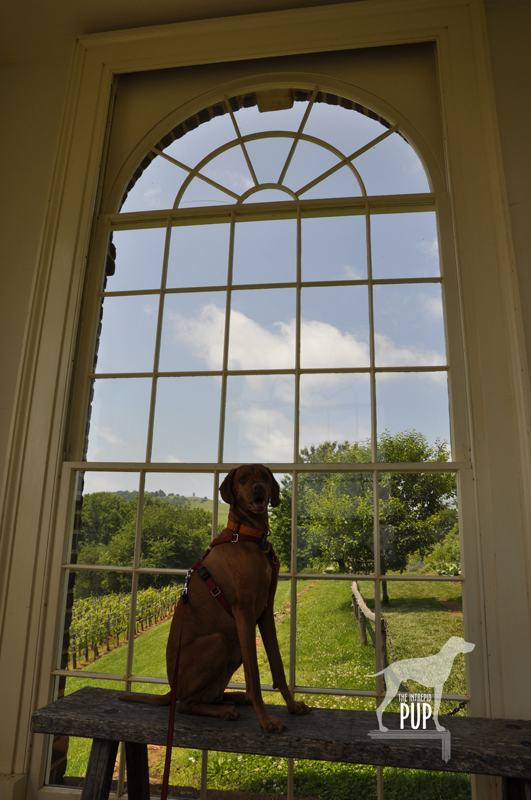
Tavish overlooks Jefferson’s gardens from the airy pavilion, much as Bergère and her progeny might have done more than 200 years ago.
Historians are always quick to cite Jefferson’s intellect and endless fascinations: natural history, architecture, gardening, cooking, viticulture, farming, literature, politics. But dogs? This founding father seemed to take a purely utilitarian view—not uncommon in late 18th-century America—of the canine species. Jefferson opined that, in general, the dog population should be highly controlled (and even regulated and taxed) as dogs often proved to be carriers of disease and a scourge upon livestock. A comprehensive article on this topic appears in the “Thomas Jefferson Encyclopedia” section of Monticello’s website.
That all being said, Jefferson also felt that certain birds and animals from the Old World should be introduced to America. Among these was a “shepherd’s dog,” and Jefferson took it upon himself to import three such dogs from France (a female named Bergère and two puppies she whelped during the trans-Atlantic passage) in 1789. There’s been much speculation as to just what kind of herding dogs these were, since Jefferson’s archival records lack this particular detail. The experts’ best guess? Large Briards. Jefferson’s farm animals included sheep, cows, and various poultry, and it seems that Bergère et al were kept as true working dogs. More of the “chien de berger” came to Monticello in 1790 and 1809, with the latter dogs personally selected by the Marquis de Lafayette! As Albemarle County landowners increasingly acquired sheep, Jefferson’s dogs came into high demand, and correspondence indicates that he carefully bred his dogs and supplied the puppies to relatives, friends and neighbors.
Bergère’s happy—but, presumably, purely coincidental—legacy is that Monticello remains a dog-friendly destination. So long as you keep your dog leashed and outdoors, dogs are welcome to explore Monticello’s historic grounds.
 38°0′35.34″N, 78°27′9.85″W
38°0′35.34″N, 78°27′9.85″W
Monticello, Charlottesville, Virginia
For Monticello’s pet-friendly culture and sheer number of things to see and do, this excursion ranks a “2” on the Intrepid Pup’s wag-a-meter.
Your visit will begin in the parking lot. Don’t miss seeing the African-American graveyard. It’s near the picnic area and entrance to the 2-mile Saunders-Monticello Trail (important note: dogs are permitted only on the section that runs through Kemper Park at the opposite end of the trail). From the parking lot you’ll approach the Visitor Center for your tickets. There’s a theater showing a 20-minute introductory film, an educational center, a cafe, and a well-stocked museum shop (sorry, no dogs in any of the buildings). Though your dog also can’t accompany you into the Robert H. and Clarice Smith Gallery, you’ll want to check this out, too. This compact museum space addresses diverse themes—from slavery to Monticello’s design—and tackles abstract concepts like Jefferson’s words and ideas in a creative way: see for yourself!
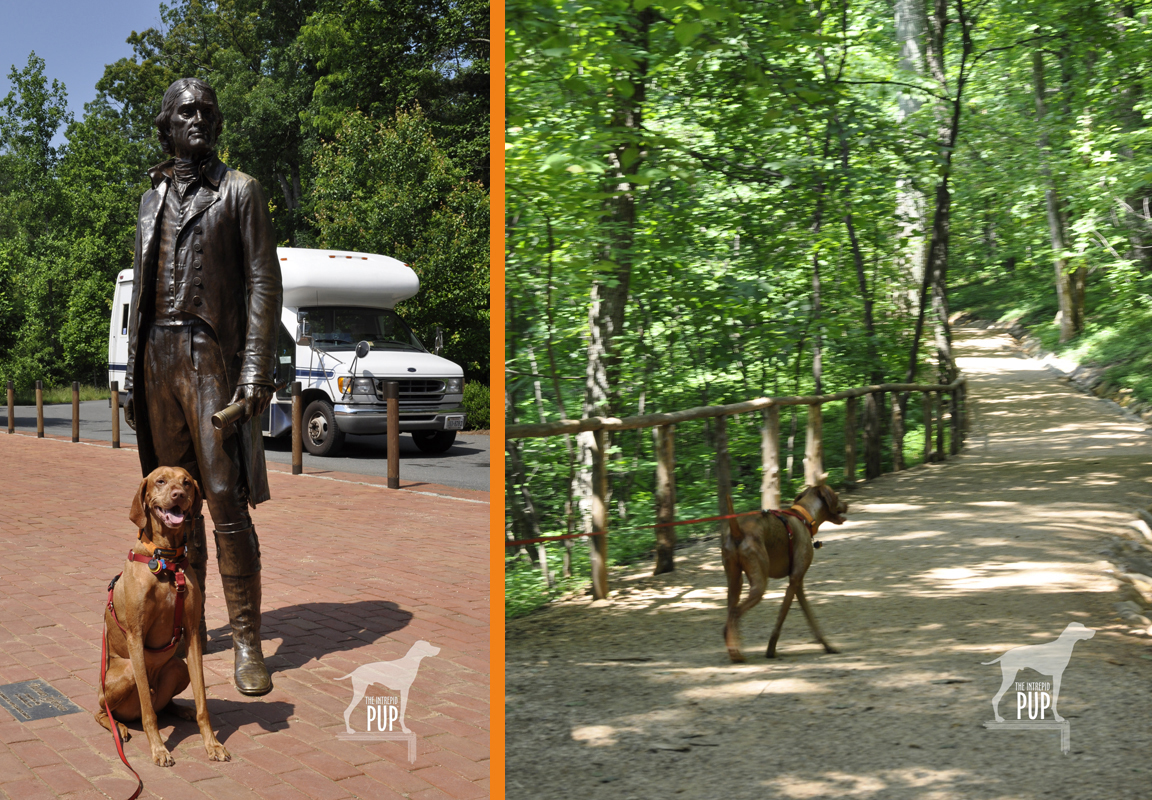
Dogs can’t take the shuttle (left), but the walking trail (right) begins just across the road from the Visitor Center shuttle stop.
To cover the distance between the Visitor Center and the house with your dog, you won’t be able to ride the courtesy shuttle. Not to worry: there’s a gently sloping, shady 0.6-mile gravel path through the woods that only takes ~20 minutes. Allow more time if you stop to linger en route at Jefferson’s gravesite.
We were pleased to find trash receptacles placed throughout the grounds (though not on the woodland trail), and we were conveniently able to refill water bottles for Tavish from restroom facilities and from the drinking fountain at the Museum Shop adjacent to Jefferson’s extensive vegetable garden.
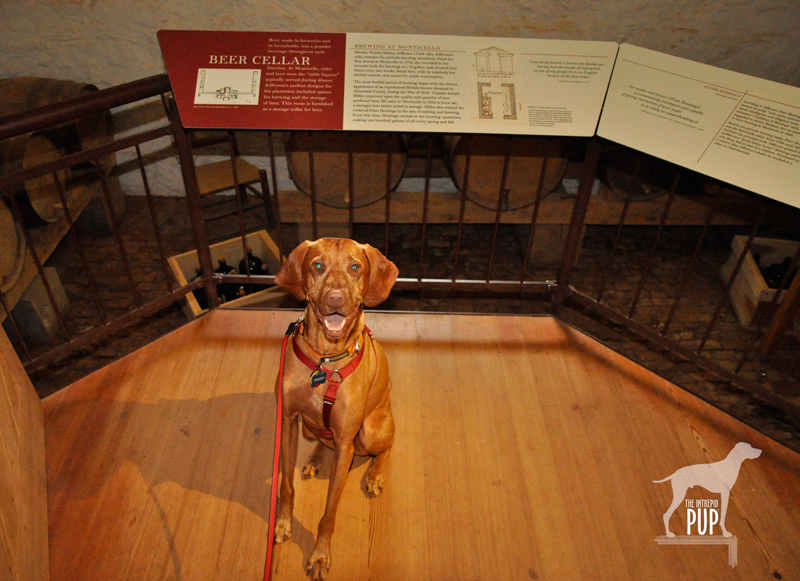
Tavish cools off in Monticello’s beer cellar. Jefferson’s wife Martha (1748-1782) oversaw the brewing of 15-gallon batches every two weeks. A British brewer visited Monticello in 1813–due to being detained in the War of 1812!–and, based on his input, the estate switched to producing biannual 100-gallon runs of ale.
Since dogs aren’t allowed inside the main house, Team Tavish took the timed-entry guided tour in consecutive one-hour shifts. This meant that Tavish had a full two hours to explore Jefferson’s estate, and there really was plenty to hold his (and our) interest. We’d been informed that Tavish could accompany us on any of the seasonally-offered “gardens and grounds” tours included in the general admission fee. While we saw many of these in progress, we opted to explore on our own and even encountered a few other visiting dogs. The beautiful flower beds on the west lawn were in full bloom, and from the north terrace we could just make out in the distance the Jefferson-designed rotunda at the University of Virginia. We surveyed the orchards from the vantage point of the garden pavilion. And when we needed some shade, we took a self-guided tour through the cool cellar passage that runs the full width of the main house and terraces and gives you a peek at Monticello’s dependencies .
Plan on spending a minimum of 3 hours at Monticello to savor the history and the views!
Save
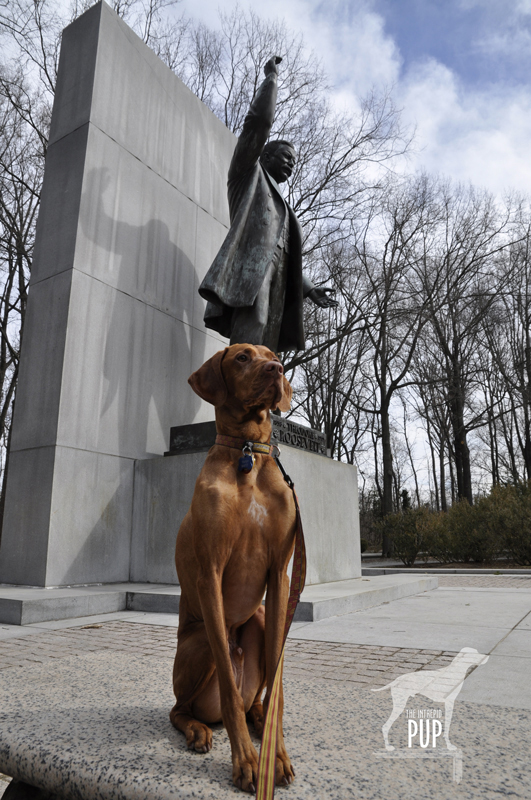 If you’re as big a fan of America’s national parks as Tavish the Intrepid Pup, then National Park Week is like having Christmas, a birthday, and the 4th of July all rolled into one. In 2012 National Park Week runs from April 21 through April 29. Jointly promoted by the National Park Service (NPS) and the National Park Foundation—the parks’ official charity—National Park Week collectively celebrates the 84 million acres preserved as “America’s best idea” by offering free admission to all 397 national park sites throughout the country. To be fair, more than 250 of these are free year-round, but in going fee free system-wide for a week, cost simply can’t be an excuse for not visiting a national park. So, in the spirit of Intrepid Pup: “Come! Adventures Await.”©
If you’re as big a fan of America’s national parks as Tavish the Intrepid Pup, then National Park Week is like having Christmas, a birthday, and the 4th of July all rolled into one. In 2012 National Park Week runs from April 21 through April 29. Jointly promoted by the National Park Service (NPS) and the National Park Foundation—the parks’ official charity—National Park Week collectively celebrates the 84 million acres preserved as “America’s best idea” by offering free admission to all 397 national park sites throughout the country. To be fair, more than 250 of these are free year-round, but in going fee free system-wide for a week, cost simply can’t be an excuse for not visiting a national park. So, in the spirit of Intrepid Pup: “Come! Adventures Await.”©
Throughout the week, Intrepid Pup will highlight various NPS sites he’s visited recently, so check back often! In the meantime, we’re starting with the Theodore Roosevelt Island National Memorial because, seriously, where better to step off National Park Week than the place dedicated to the guy who first made the environment and national parks central to domestic policy?
Theodore Roosevelt (1858-1919) became the the youngest man to ascend to the U.S. presidency, taking over when President McKinley’s term ended prematurely with an assassin’s bullet. While Roosevelt can’t lay claim to designating Yellowstone the country’s first national park (President Grant had that honor in 1872) or even to establishing the National Park Service (President Wilson got the credit in 1916), he arguably did more to shape the tenor of American resource conservation than any president before or since. During Roosevelt’s 1901-1909 tenure as the 26th president of the United States, he created five national parks and established the U.S. Forest Service. With the passage of the 1906 Antiquities Act he provided the precedent and legislative vehicle for presidents to protect historically significant sites as National Monuments…of which he then personally authorized 18. All told, among national forests, parks, game preserves, bird reservations and national monuments Roosevelt amassed a legacy of preserving a staggering 230 million acres of public land.
To visit Roosevelt Island today is to step onto a sylvan oasis. Wedged between Virginia and the District of Columbia’s banks of the Potomac River, this 88-acre dollop has had a schizophrenic past: Inhabited by 16th-century Native Americans. Overtaken by various colonials in the 18th century. Owned by George Mason (author of the Virginia Declaration of Rights) and later by his son in the early 19th century for entertaining high society in a summer house built upon its ridge. Utilized by the 1st U.S. Colored Troops as a Civil War mustering ground in 1863. Cherished as a safe haven for escaped and freed slaves fleeing the South between May 1864 and June 1865.
The Roosevelt connection didn’t come until the 1930s, when the Theodore Roosevelt Association acquired the island and promptly transferred title to the National Park Service. Initial efforts to create the only capital-area memorial to Roosevelt involved the Civilian Conservation Corps removing invasive vegetation and planting nearly 20,000 native trees. Frederick Law Olmsted Jr. (1870-1957) was enlisted to come up with an overall design. Various issues hampered progress, including World War II, and the project wasn’t resumed until the 1960s. Though Olmsted had passed away in the intervening years, many of his original ideas like a Memorial Plaza and foot trails survived the final plan put forth by Eric Gugler (1889-1974). Paul Manship (1885-1966)—perhaps better remembered for his Prometheus Fountain in New York City’s Rockefeller Center—designed the 17-foot bronze statue of Roosevelt ultimately dedicated on the site in 1967.
In Tavish’s visits to the island, we invariably begin at the expansive Memorial Plaza where Roosevelt stands at the far end, backed by a 30-foot granite shaft, right arm raised above his head as if he were in the midst of an animated speech. Four 21-foot granite tablets bear Roosevelt quotations under the headings of Nature, Manhood, Youth, and The State. Three trails (Swamp, Woods, and Upland) radiate from the plaza; none are longer than 1.3 miles. Except for a traffic helicopter’s shadow raking through the tree canopy or the dull roar of a Dc-9 following the river southward on its final approach to Ronald Reagan-Washington National Airport, you’d never believe you’re so close to the city. Don’t go expecting dazzling waterfront views; for most of the year, heavy foliage occludes shoreline panoramas of the Kennedy Center, the Watergate and Georgetown. The Potomac River is tidal but it’s fresh water that infiltrates the marshland skirting the Swamp Trail’s boardwalk. On our most recent jaunt yesterday, yellow irises were in bloom. Low tide had temporarily marooned minnows in the shallows. We spotted numerous marsh birds and encountered three deer grazing on green tendrils mere feet from the boardwalk. Two salamanders basking in the sun skittered away when we approached.
Roosevelt Island is one of five NPS sites—if you don’t count his visage on Mount Rushmore—specifically honoring our 26th President. (Intrepid Pup bonus points if you can name the others! Answers are below.*) In hiking the island, Roosevelt’s foresight for preserving parkland is readily appreciated. As one of his quotations chiseled in the nearby stone states:
“The nation behaves well if it treats the natural resources as assets
which it must turn over to the next generation increased and not impaired in value.”
Thanks, Teddy!
38°53′50.70″N, 77°3′50.22″W
Theodore Roosevelt Island National Memorial, Virginia
 By car, one can only reach the parking lot for Roosevelt Island from the northbound lanes of the George Washington Memorial Parkway. The lot serves as a trailhead for runners and cyclists on more far-flung journeys along the Mount Vernon and Potomac Heritage Trails. Though most who park here likely never cross the pedestrian bridge onto the island, the grounds nonetheless attract a fair share of walkers and joggers. Dogs are permitted on the island but must be on a 6-foot leash at all times. As always, pick up after your dog. Trash receptacles are understandably sparse along the island’s trails but are abundant in the parking area.
By car, one can only reach the parking lot for Roosevelt Island from the northbound lanes of the George Washington Memorial Parkway. The lot serves as a trailhead for runners and cyclists on more far-flung journeys along the Mount Vernon and Potomac Heritage Trails. Though most who park here likely never cross the pedestrian bridge onto the island, the grounds nonetheless attract a fair share of walkers and joggers. Dogs are permitted on the island but must be on a 6-foot leash at all times. As always, pick up after your dog. Trash receptacles are understandably sparse along the island’s trails but are abundant in the parking area.
Be aware that low-lying areas of the island flood easily, and sections of trail are seasonally boggy or otherwise closed. Consult the bulletin board on the island side of the pedestrian bridge for current trail info. Bear right and make the first left uphill to view the Memorial Plaza; otherwise stay right to embark on the Swamp Trail that encircles the island. The Island scores a “1” on the Intrepid Pup Wag-a-Meter for its easy hiking.
*The other four Roosevelt-related NPS sites are Roosevelt National Park (North Dakota), the Roosevelt Birthplace National Historic Site (New York City), Sagamore Hill National Historic Site (Oyster Bay, NY), and the Roosevelt Inaugural National Historic Site (Buffalo, NY).
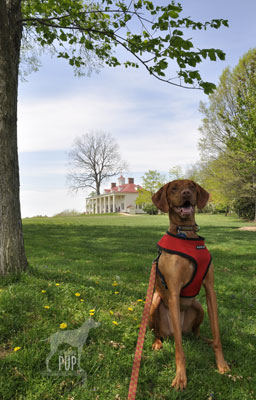 “First in war, first in peace and first in the hearts of his countrymen….”
“First in war, first in peace and first in the hearts of his countrymen….”
When it comes to being truly intrepid, one has to look no further than America’s first president, George Washington. The above words were spoken by Henry “Light-Horse Harry” Lee in 1799 in a public eulogy upon Washington’s untimely death and have aptly endured for generations.
With George Washington’s 280th birthday approaching on February 22, 2012, Team Tavish figured that Washington’s Mount Vernon Estate and Gardens would be a fitting topic for the Intrepid Pup’s inaugural blog post.
The extensive grounds are indeed dog-friendly (see “Dogging the Details” below), perhaps in a nod to Washington’s own affinity for dogs. In a tidbit of canine trivia, Washington is credited as being the father of the American Foxhound breed. He imported several hounds from England in 1770 and received more from France’s Marquis de Lafayette in 1785. According to the American Kennel Club, more than 30 hounds are referenced in Washington’s records, and it isn’t difficult to imagine them accompanying Washington as he surveyed, hunted, and managed the 8,000+ acres that once constituted the full extent of his Mount Vernon estate.
Tavish has visited on multiple occasions. He has had to leave touring the meticulously-restored mansion and experiencing the impressive educational complex—which opened in 2006 and comprehensively addresses various aspects of Washington’s public and private persona and legacy through immersive presentations, interpretive exhibitions, and more than 1,000 artifacts—to Team Tavish. But if you think there might not be much else for a dog to do, you’d be wrong. Consider sitting in one of the Windsor chairs on the back porch and admiring the sweeping view of the Potomac River. Explore the treading barn at the Pioneer Farm site and sniff the blooms grown from heirloom seeds in the ever-changing gardens. Walk solemnly past Washington’s tomb and the slave burial ground memorial. Greet visitors arriving by boat down at the dock. Peer through the fences and snuffle at any number of heritage breed animals that include hogs, oxen, and even Liberty (the National Thanksgiving Day turkey officially pardoned by President Obama on November 23, 2011, living out its days at Mount Vernon)! And if it’s the holiday season, follow in Tavish’s paw prints and be sure to check out the live camel. It’s true. During the Christmas season of 1787, George Washington paid 18 shillings for the novelty of temporarily boarding a camel to entertain his holiday guests. Mount Vernon keeps with the tradition by having a “Christmas Camel” on site during its annual Christmas at Mount Vernon festivities.
38°42′29.65″ N, 77°05′07.67″ W
George Washington’s Mount Vernon Estate & Gardens, Alexandria, Virginia
 Bring your annual pass, dog, and a leash! Mount Vernon earns a “2” on the Intrepid Pup Wag-A-Meter for generously giving annual pass holders dog-walking rights on the grounds during regular daytime visitation hours. If you plan to visit Mount Vernon more than once in any given year, then the annual pass is well worth it. The usual rules apply: keep your dog on a leash and be sure to clean up. Dogs aren’t allowed in the mansion, outbuildings, Ford Orientation Center, or Donald W. Reynolds Museum and Education Center, but with ~500 acres of grounds, gardens, and woodland trails, there’s plenty outside to explore. Mount Vernon has a few strategically-placed water bowls on the grounds for its canine friends, but if you’re planning an extended visit, bring along extra water for your dog. Mount Vernon attracts approximately 1 million visitors annually. On President’s Day, admission to Mount Vernon is free, but be forewarned that it’s also one of the Estate’s busiest days of the year!
Bring your annual pass, dog, and a leash! Mount Vernon earns a “2” on the Intrepid Pup Wag-A-Meter for generously giving annual pass holders dog-walking rights on the grounds during regular daytime visitation hours. If you plan to visit Mount Vernon more than once in any given year, then the annual pass is well worth it. The usual rules apply: keep your dog on a leash and be sure to clean up. Dogs aren’t allowed in the mansion, outbuildings, Ford Orientation Center, or Donald W. Reynolds Museum and Education Center, but with ~500 acres of grounds, gardens, and woodland trails, there’s plenty outside to explore. Mount Vernon has a few strategically-placed water bowls on the grounds for its canine friends, but if you’re planning an extended visit, bring along extra water for your dog. Mount Vernon attracts approximately 1 million visitors annually. On President’s Day, admission to Mount Vernon is free, but be forewarned that it’s also one of the Estate’s busiest days of the year!

#IntrepidPupYonder #vizsla
... See MoreSee Less

1 CommentComment on Facebook
I should have known that!

Team Tavish consists of a husband-wife duo with approximately 35 years of combined professional experience in museums. They’re nature enthusiasts, museum/national park/cultural site omnivores, urban … [ Read more...]

Friends, the moment we knew would inevitably arrive has happened. Friday evening with our beloved vizsla Tavish was our last. What many of you may not have known was that in March, Tavish received a serious diagnosis. In putting him first—and … [Read More...]
Fetch the latest #ArtfulPup features
Guess these dog-friendly #WITWW mystery locations

